The Business and Legal Environment: A Comprehensive Report for MGL112
VerifiedAdded on 2023/03/29
|10
|2314
|205
Report
AI Summary
This report addresses three key legal areas within the business environment. Firstly, it explores tort law, focusing on negligence, the duty of care, and the Caparo test, analyzing how these principles apply in real-world scenarios such as the Eldorado Shopping Centre case. Secondly, it examines the determination of employment status, comparing the control test, multi-factor test, and integration test to differentiate between employees and independent contractors, illustrated with the case of Edam and Imperial Pty Ltd. Finally, the report delves into workplace health and safety laws in Australia, outlining federal and Victorian legislation like the Workplace Health and Safety Regulation 2011 and the Occupational Health and Safety Act 2004, as well as the Workplace Injury Rehabilitation and Compensation Act 2013, emphasizing the employer's responsibilities and the definition of workplace injury.
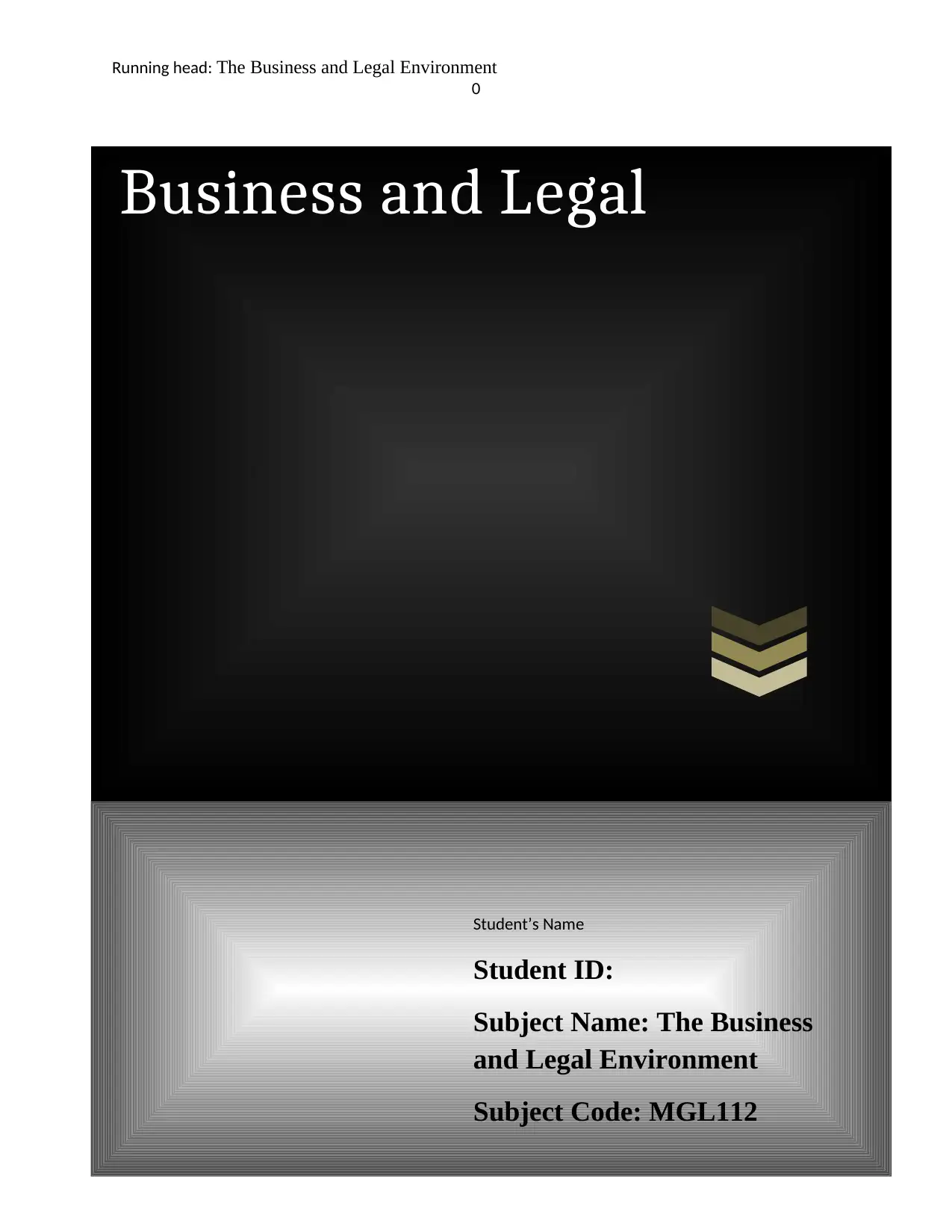
Business and Legal
Running head: The Business and Legal Environment
0
Student’s Name
Student ID:
Subject Name: The Business
and Legal Environment
Subject Code: MGL112
Running head: The Business and Legal Environment
0
Student’s Name
Student ID:
Subject Name: The Business
and Legal Environment
Subject Code: MGL112
Paraphrase This Document
Need a fresh take? Get an instant paraphrase of this document with our AI Paraphraser
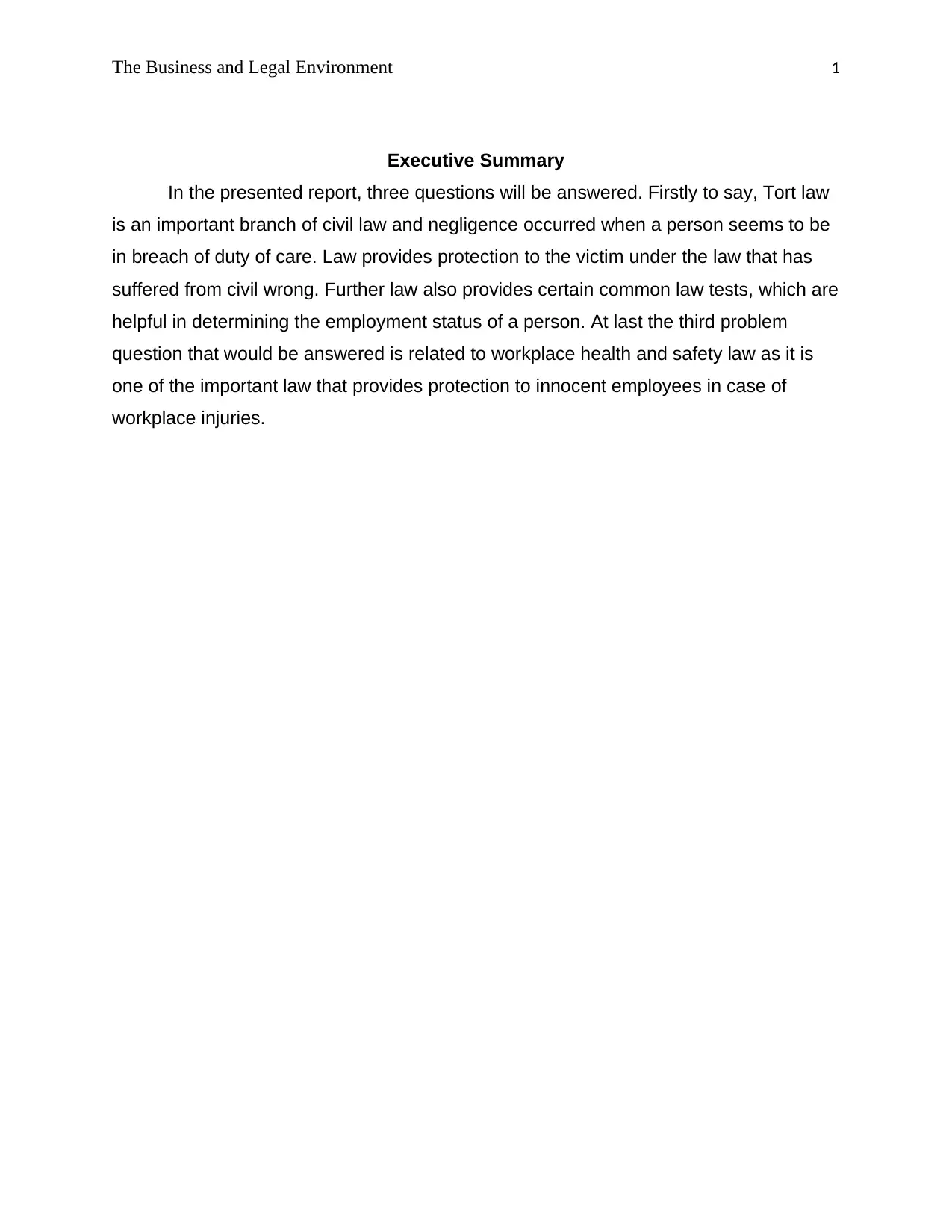
The Business and Legal Environment 1
Executive Summary
In the presented report, three questions will be answered. Firstly to say, Tort law
is an important branch of civil law and negligence occurred when a person seems to be
in breach of duty of care. Law provides protection to the victim under the law that has
suffered from civil wrong. Further law also provides certain common law tests, which are
helpful in determining the employment status of a person. At last the third problem
question that would be answered is related to workplace health and safety law as it is
one of the important law that provides protection to innocent employees in case of
workplace injuries.
Executive Summary
In the presented report, three questions will be answered. Firstly to say, Tort law
is an important branch of civil law and negligence occurred when a person seems to be
in breach of duty of care. Law provides protection to the victim under the law that has
suffered from civil wrong. Further law also provides certain common law tests, which are
helpful in determining the employment status of a person. At last the third problem
question that would be answered is related to workplace health and safety law as it is
one of the important law that provides protection to innocent employees in case of
workplace injuries.
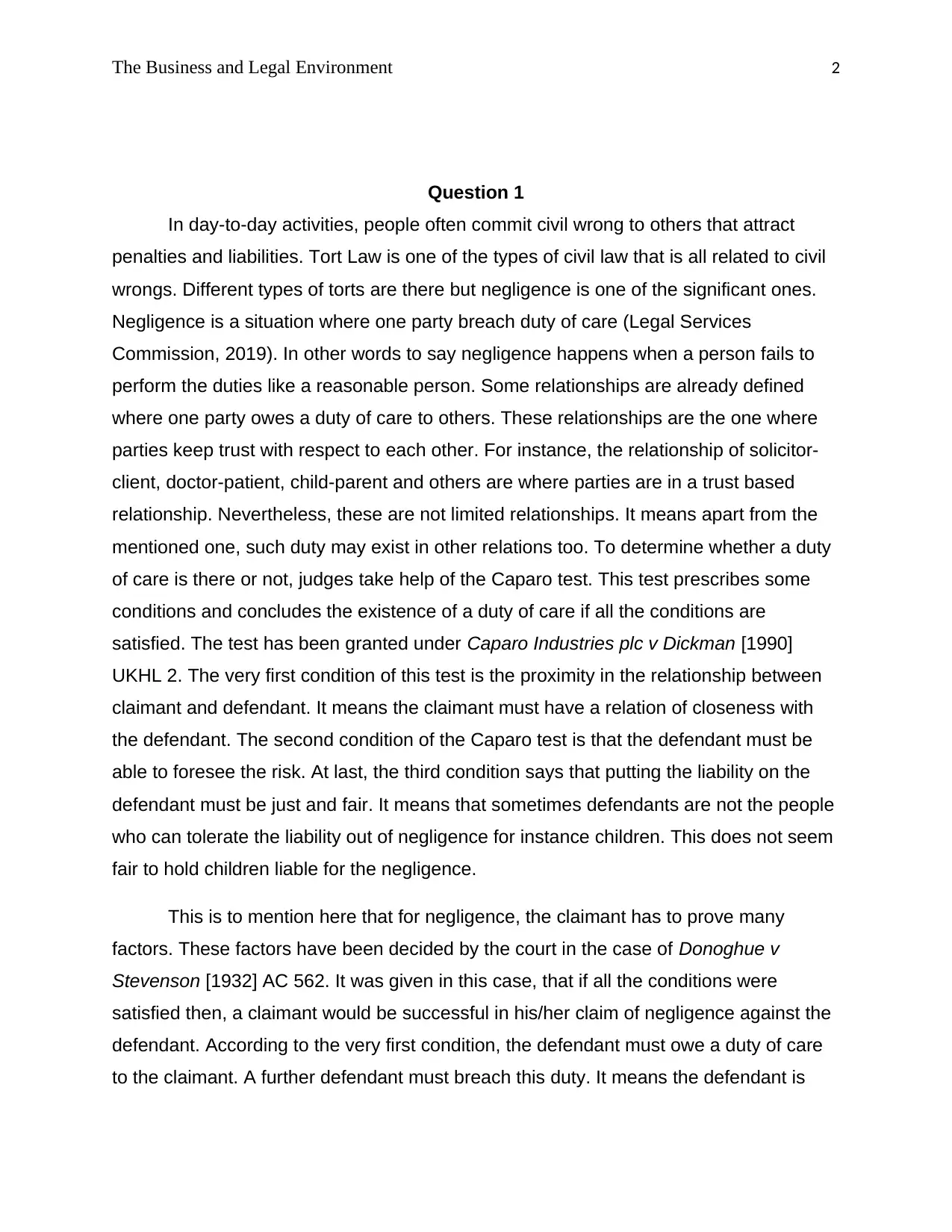
The Business and Legal Environment 2
Question 1
In day-to-day activities, people often commit civil wrong to others that attract
penalties and liabilities. Tort Law is one of the types of civil law that is all related to civil
wrongs. Different types of torts are there but negligence is one of the significant ones.
Negligence is a situation where one party breach duty of care (Legal Services
Commission, 2019). In other words to say negligence happens when a person fails to
perform the duties like a reasonable person. Some relationships are already defined
where one party owes a duty of care to others. These relationships are the one where
parties keep trust with respect to each other. For instance, the relationship of solicitor-
client, doctor-patient, child-parent and others are where parties are in a trust based
relationship. Nevertheless, these are not limited relationships. It means apart from the
mentioned one, such duty may exist in other relations too. To determine whether a duty
of care is there or not, judges take help of the Caparo test. This test prescribes some
conditions and concludes the existence of a duty of care if all the conditions are
satisfied. The test has been granted under Caparo Industries plc v Dickman [1990]
UKHL 2. The very first condition of this test is the proximity in the relationship between
claimant and defendant. It means the claimant must have a relation of closeness with
the defendant. The second condition of the Caparo test is that the defendant must be
able to foresee the risk. At last, the third condition says that putting the liability on the
defendant must be just and fair. It means that sometimes defendants are not the people
who can tolerate the liability out of negligence for instance children. This does not seem
fair to hold children liable for the negligence.
This is to mention here that for negligence, the claimant has to prove many
factors. These factors have been decided by the court in the case of Donoghue v
Stevenson [1932] AC 562. It was given in this case, that if all the conditions were
satisfied then, a claimant would be successful in his/her claim of negligence against the
defendant. According to the very first condition, the defendant must owe a duty of care
to the claimant. A further defendant must breach this duty. It means the defendant is
Question 1
In day-to-day activities, people often commit civil wrong to others that attract
penalties and liabilities. Tort Law is one of the types of civil law that is all related to civil
wrongs. Different types of torts are there but negligence is one of the significant ones.
Negligence is a situation where one party breach duty of care (Legal Services
Commission, 2019). In other words to say negligence happens when a person fails to
perform the duties like a reasonable person. Some relationships are already defined
where one party owes a duty of care to others. These relationships are the one where
parties keep trust with respect to each other. For instance, the relationship of solicitor-
client, doctor-patient, child-parent and others are where parties are in a trust based
relationship. Nevertheless, these are not limited relationships. It means apart from the
mentioned one, such duty may exist in other relations too. To determine whether a duty
of care is there or not, judges take help of the Caparo test. This test prescribes some
conditions and concludes the existence of a duty of care if all the conditions are
satisfied. The test has been granted under Caparo Industries plc v Dickman [1990]
UKHL 2. The very first condition of this test is the proximity in the relationship between
claimant and defendant. It means the claimant must have a relation of closeness with
the defendant. The second condition of the Caparo test is that the defendant must be
able to foresee the risk. At last, the third condition says that putting the liability on the
defendant must be just and fair. It means that sometimes defendants are not the people
who can tolerate the liability out of negligence for instance children. This does not seem
fair to hold children liable for the negligence.
This is to mention here that for negligence, the claimant has to prove many
factors. These factors have been decided by the court in the case of Donoghue v
Stevenson [1932] AC 562. It was given in this case, that if all the conditions were
satisfied then, a claimant would be successful in his/her claim of negligence against the
defendant. According to the very first condition, the defendant must owe a duty of care
to the claimant. A further defendant must breach this duty. It means the defendant is
⊘ This is a preview!⊘
Do you want full access?
Subscribe today to unlock all pages.

Trusted by 1+ million students worldwide
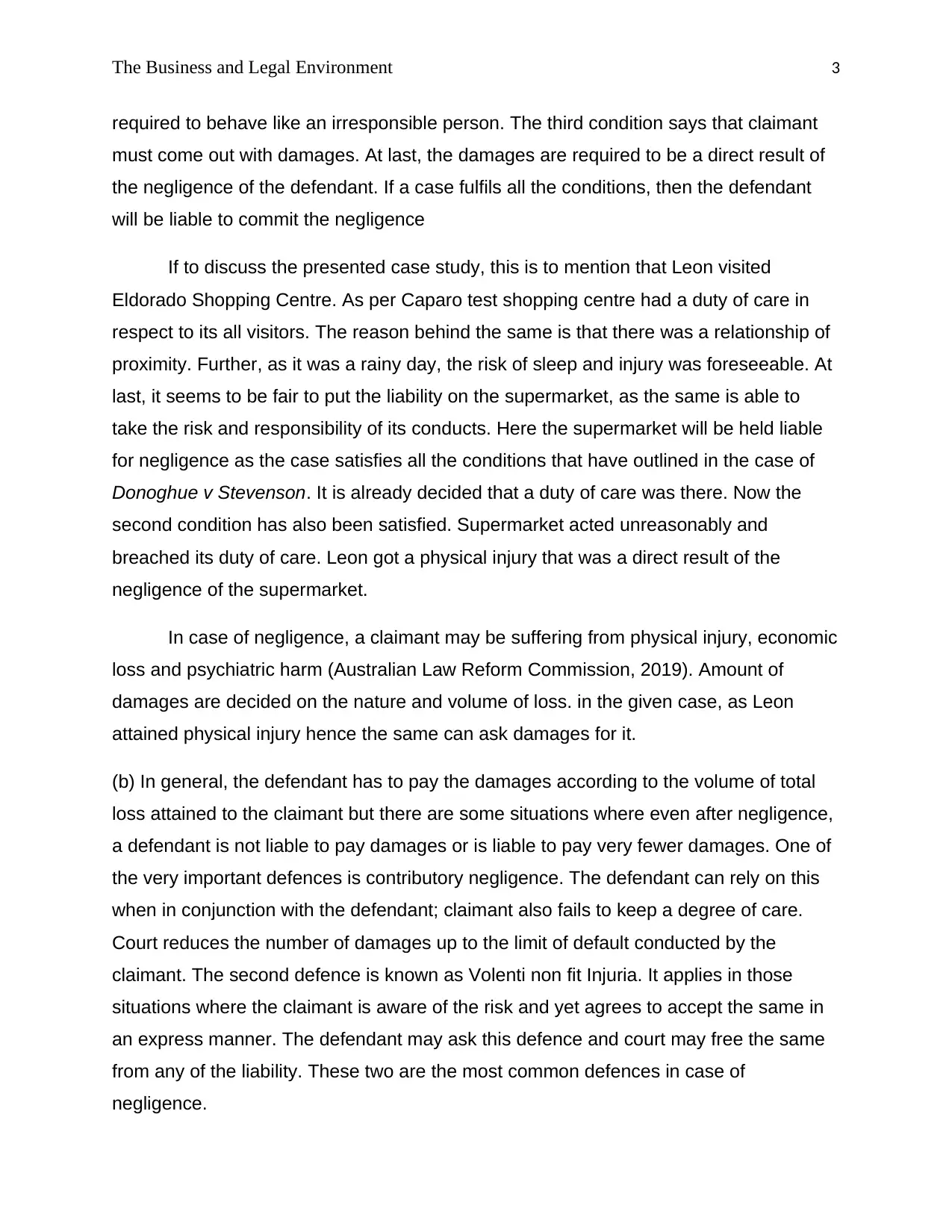
The Business and Legal Environment 3
required to behave like an irresponsible person. The third condition says that claimant
must come out with damages. At last, the damages are required to be a direct result of
the negligence of the defendant. If a case fulfils all the conditions, then the defendant
will be liable to commit the negligence
If to discuss the presented case study, this is to mention that Leon visited
Eldorado Shopping Centre. As per Caparo test shopping centre had a duty of care in
respect to its all visitors. The reason behind the same is that there was a relationship of
proximity. Further, as it was a rainy day, the risk of sleep and injury was foreseeable. At
last, it seems to be fair to put the liability on the supermarket, as the same is able to
take the risk and responsibility of its conducts. Here the supermarket will be held liable
for negligence as the case satisfies all the conditions that have outlined in the case of
Donoghue v Stevenson. It is already decided that a duty of care was there. Now the
second condition has also been satisfied. Supermarket acted unreasonably and
breached its duty of care. Leon got a physical injury that was a direct result of the
negligence of the supermarket.
In case of negligence, a claimant may be suffering from physical injury, economic
loss and psychiatric harm (Australian Law Reform Commission, 2019). Amount of
damages are decided on the nature and volume of loss. in the given case, as Leon
attained physical injury hence the same can ask damages for it.
(b) In general, the defendant has to pay the damages according to the volume of total
loss attained to the claimant but there are some situations where even after negligence,
a defendant is not liable to pay damages or is liable to pay very fewer damages. One of
the very important defences is contributory negligence. The defendant can rely on this
when in conjunction with the defendant; claimant also fails to keep a degree of care.
Court reduces the number of damages up to the limit of default conducted by the
claimant. The second defence is known as Volenti non fit Injuria. It applies in those
situations where the claimant is aware of the risk and yet agrees to accept the same in
an express manner. The defendant may ask this defence and court may free the same
from any of the liability. These two are the most common defences in case of
negligence.
required to behave like an irresponsible person. The third condition says that claimant
must come out with damages. At last, the damages are required to be a direct result of
the negligence of the defendant. If a case fulfils all the conditions, then the defendant
will be liable to commit the negligence
If to discuss the presented case study, this is to mention that Leon visited
Eldorado Shopping Centre. As per Caparo test shopping centre had a duty of care in
respect to its all visitors. The reason behind the same is that there was a relationship of
proximity. Further, as it was a rainy day, the risk of sleep and injury was foreseeable. At
last, it seems to be fair to put the liability on the supermarket, as the same is able to
take the risk and responsibility of its conducts. Here the supermarket will be held liable
for negligence as the case satisfies all the conditions that have outlined in the case of
Donoghue v Stevenson. It is already decided that a duty of care was there. Now the
second condition has also been satisfied. Supermarket acted unreasonably and
breached its duty of care. Leon got a physical injury that was a direct result of the
negligence of the supermarket.
In case of negligence, a claimant may be suffering from physical injury, economic
loss and psychiatric harm (Australian Law Reform Commission, 2019). Amount of
damages are decided on the nature and volume of loss. in the given case, as Leon
attained physical injury hence the same can ask damages for it.
(b) In general, the defendant has to pay the damages according to the volume of total
loss attained to the claimant but there are some situations where even after negligence,
a defendant is not liable to pay damages or is liable to pay very fewer damages. One of
the very important defences is contributory negligence. The defendant can rely on this
when in conjunction with the defendant; claimant also fails to keep a degree of care.
Court reduces the number of damages up to the limit of default conducted by the
claimant. The second defence is known as Volenti non fit Injuria. It applies in those
situations where the claimant is aware of the risk and yet agrees to accept the same in
an express manner. The defendant may ask this defence and court may free the same
from any of the liability. These two are the most common defences in case of
negligence.
Paraphrase This Document
Need a fresh take? Get an instant paraphrase of this document with our AI Paraphraser
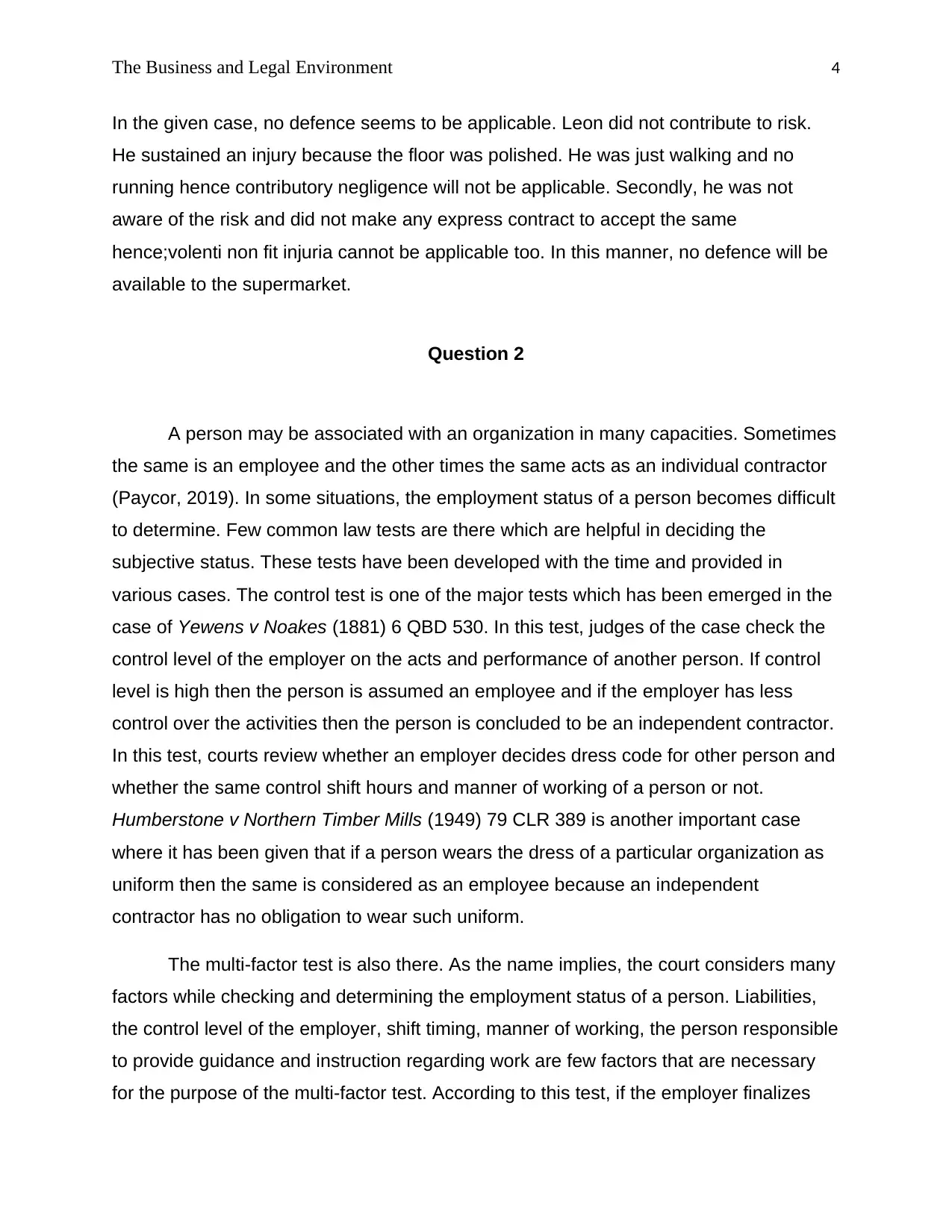
The Business and Legal Environment 4
In the given case, no defence seems to be applicable. Leon did not contribute to risk.
He sustained an injury because the floor was polished. He was just walking and no
running hence contributory negligence will not be applicable. Secondly, he was not
aware of the risk and did not make any express contract to accept the same
hence;volenti non fit injuria cannot be applicable too. In this manner, no defence will be
available to the supermarket.
Question 2
A person may be associated with an organization in many capacities. Sometimes
the same is an employee and the other times the same acts as an individual contractor
(Paycor, 2019). In some situations, the employment status of a person becomes difficult
to determine. Few common law tests are there which are helpful in deciding the
subjective status. These tests have been developed with the time and provided in
various cases. The control test is one of the major tests which has been emerged in the
case of Yewens v Noakes (1881) 6 QBD 530. In this test, judges of the case check the
control level of the employer on the acts and performance of another person. If control
level is high then the person is assumed an employee and if the employer has less
control over the activities then the person is concluded to be an independent contractor.
In this test, courts review whether an employer decides dress code for other person and
whether the same control shift hours and manner of working of a person or not.
Humberstone v Northern Timber Mills (1949) 79 CLR 389 is another important case
where it has been given that if a person wears the dress of a particular organization as
uniform then the same is considered as an employee because an independent
contractor has no obligation to wear such uniform.
The multi-factor test is also there. As the name implies, the court considers many
factors while checking and determining the employment status of a person. Liabilities,
the control level of the employer, shift timing, manner of working, the person responsible
to provide guidance and instruction regarding work are few factors that are necessary
for the purpose of the multi-factor test. According to this test, if the employer finalizes
In the given case, no defence seems to be applicable. Leon did not contribute to risk.
He sustained an injury because the floor was polished. He was just walking and no
running hence contributory negligence will not be applicable. Secondly, he was not
aware of the risk and did not make any express contract to accept the same
hence;volenti non fit injuria cannot be applicable too. In this manner, no defence will be
available to the supermarket.
Question 2
A person may be associated with an organization in many capacities. Sometimes
the same is an employee and the other times the same acts as an individual contractor
(Paycor, 2019). In some situations, the employment status of a person becomes difficult
to determine. Few common law tests are there which are helpful in deciding the
subjective status. These tests have been developed with the time and provided in
various cases. The control test is one of the major tests which has been emerged in the
case of Yewens v Noakes (1881) 6 QBD 530. In this test, judges of the case check the
control level of the employer on the acts and performance of another person. If control
level is high then the person is assumed an employee and if the employer has less
control over the activities then the person is concluded to be an independent contractor.
In this test, courts review whether an employer decides dress code for other person and
whether the same control shift hours and manner of working of a person or not.
Humberstone v Northern Timber Mills (1949) 79 CLR 389 is another important case
where it has been given that if a person wears the dress of a particular organization as
uniform then the same is considered as an employee because an independent
contractor has no obligation to wear such uniform.
The multi-factor test is also there. As the name implies, the court considers many
factors while checking and determining the employment status of a person. Liabilities,
the control level of the employer, shift timing, manner of working, the person responsible
to provide guidance and instruction regarding work are few factors that are necessary
for the purpose of the multi-factor test. According to this test, if the employer finalizes
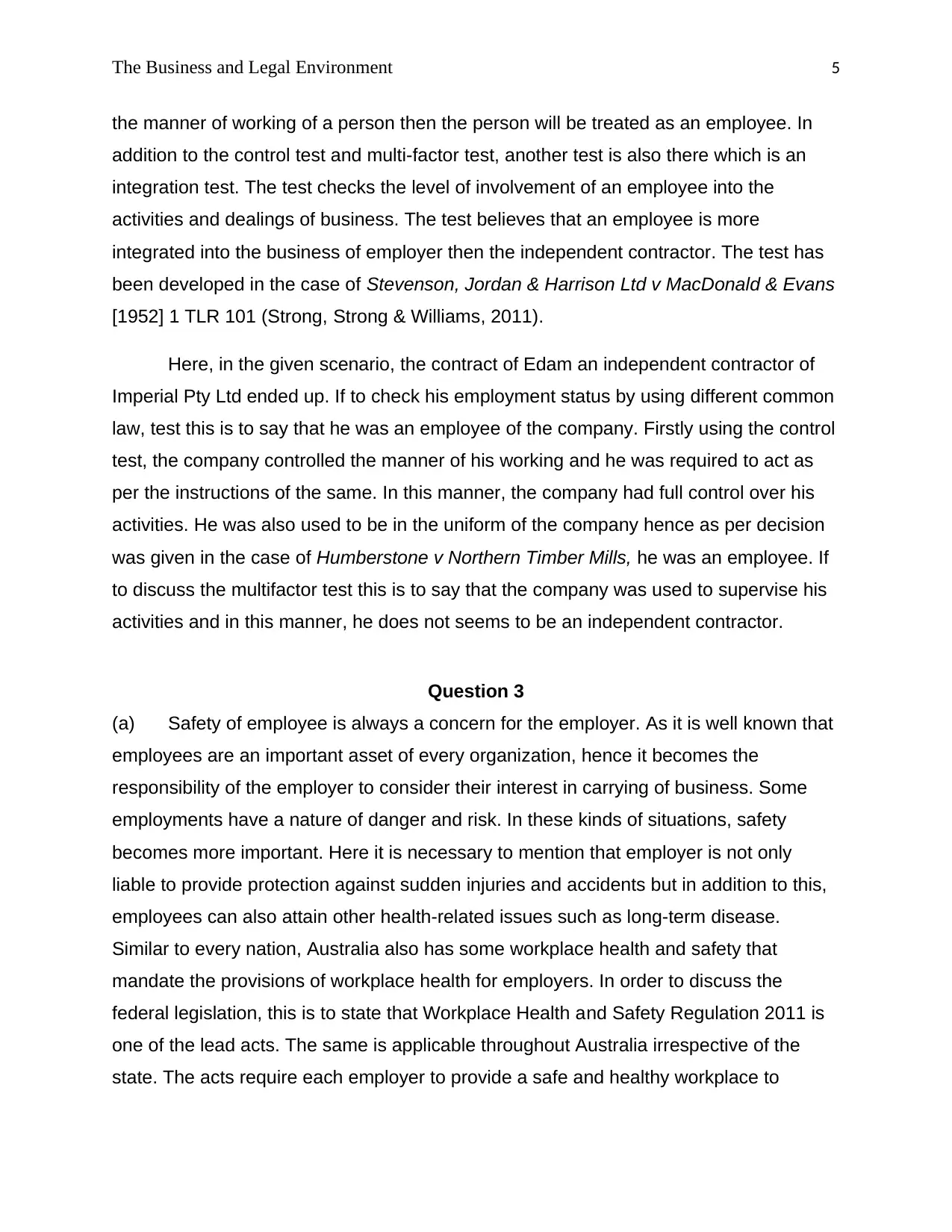
The Business and Legal Environment 5
the manner of working of a person then the person will be treated as an employee. In
addition to the control test and multi-factor test, another test is also there which is an
integration test. The test checks the level of involvement of an employee into the
activities and dealings of business. The test believes that an employee is more
integrated into the business of employer then the independent contractor. The test has
been developed in the case of Stevenson, Jordan & Harrison Ltd v MacDonald & Evans
[1952] 1 TLR 101 (Strong, Strong & Williams, 2011).
Here, in the given scenario, the contract of Edam an independent contractor of
Imperial Pty Ltd ended up. If to check his employment status by using different common
law, test this is to say that he was an employee of the company. Firstly using the control
test, the company controlled the manner of his working and he was required to act as
per the instructions of the same. In this manner, the company had full control over his
activities. He was also used to be in the uniform of the company hence as per decision
was given in the case of Humberstone v Northern Timber Mills, he was an employee. If
to discuss the multifactor test this is to say that the company was used to supervise his
activities and in this manner, he does not seems to be an independent contractor.
Question 3
(a) Safety of employee is always a concern for the employer. As it is well known that
employees are an important asset of every organization, hence it becomes the
responsibility of the employer to consider their interest in carrying of business. Some
employments have a nature of danger and risk. In these kinds of situations, safety
becomes more important. Here it is necessary to mention that employer is not only
liable to provide protection against sudden injuries and accidents but in addition to this,
employees can also attain other health-related issues such as long-term disease.
Similar to every nation, Australia also has some workplace health and safety that
mandate the provisions of workplace health for employers. In order to discuss the
federal legislation, this is to state that Workplace Health and Safety Regulation 2011 is
one of the lead acts. The same is applicable throughout Australia irrespective of the
state. The acts require each employer to provide a safe and healthy workplace to
the manner of working of a person then the person will be treated as an employee. In
addition to the control test and multi-factor test, another test is also there which is an
integration test. The test checks the level of involvement of an employee into the
activities and dealings of business. The test believes that an employee is more
integrated into the business of employer then the independent contractor. The test has
been developed in the case of Stevenson, Jordan & Harrison Ltd v MacDonald & Evans
[1952] 1 TLR 101 (Strong, Strong & Williams, 2011).
Here, in the given scenario, the contract of Edam an independent contractor of
Imperial Pty Ltd ended up. If to check his employment status by using different common
law, test this is to say that he was an employee of the company. Firstly using the control
test, the company controlled the manner of his working and he was required to act as
per the instructions of the same. In this manner, the company had full control over his
activities. He was also used to be in the uniform of the company hence as per decision
was given in the case of Humberstone v Northern Timber Mills, he was an employee. If
to discuss the multifactor test this is to say that the company was used to supervise his
activities and in this manner, he does not seems to be an independent contractor.
Question 3
(a) Safety of employee is always a concern for the employer. As it is well known that
employees are an important asset of every organization, hence it becomes the
responsibility of the employer to consider their interest in carrying of business. Some
employments have a nature of danger and risk. In these kinds of situations, safety
becomes more important. Here it is necessary to mention that employer is not only
liable to provide protection against sudden injuries and accidents but in addition to this,
employees can also attain other health-related issues such as long-term disease.
Similar to every nation, Australia also has some workplace health and safety that
mandate the provisions of workplace health for employers. In order to discuss the
federal legislation, this is to state that Workplace Health and Safety Regulation 2011 is
one of the lead acts. The same is applicable throughout Australia irrespective of the
state. The acts require each employer to provide a safe and healthy workplace to
⊘ This is a preview!⊘
Do you want full access?
Subscribe today to unlock all pages.

Trusted by 1+ million students worldwide
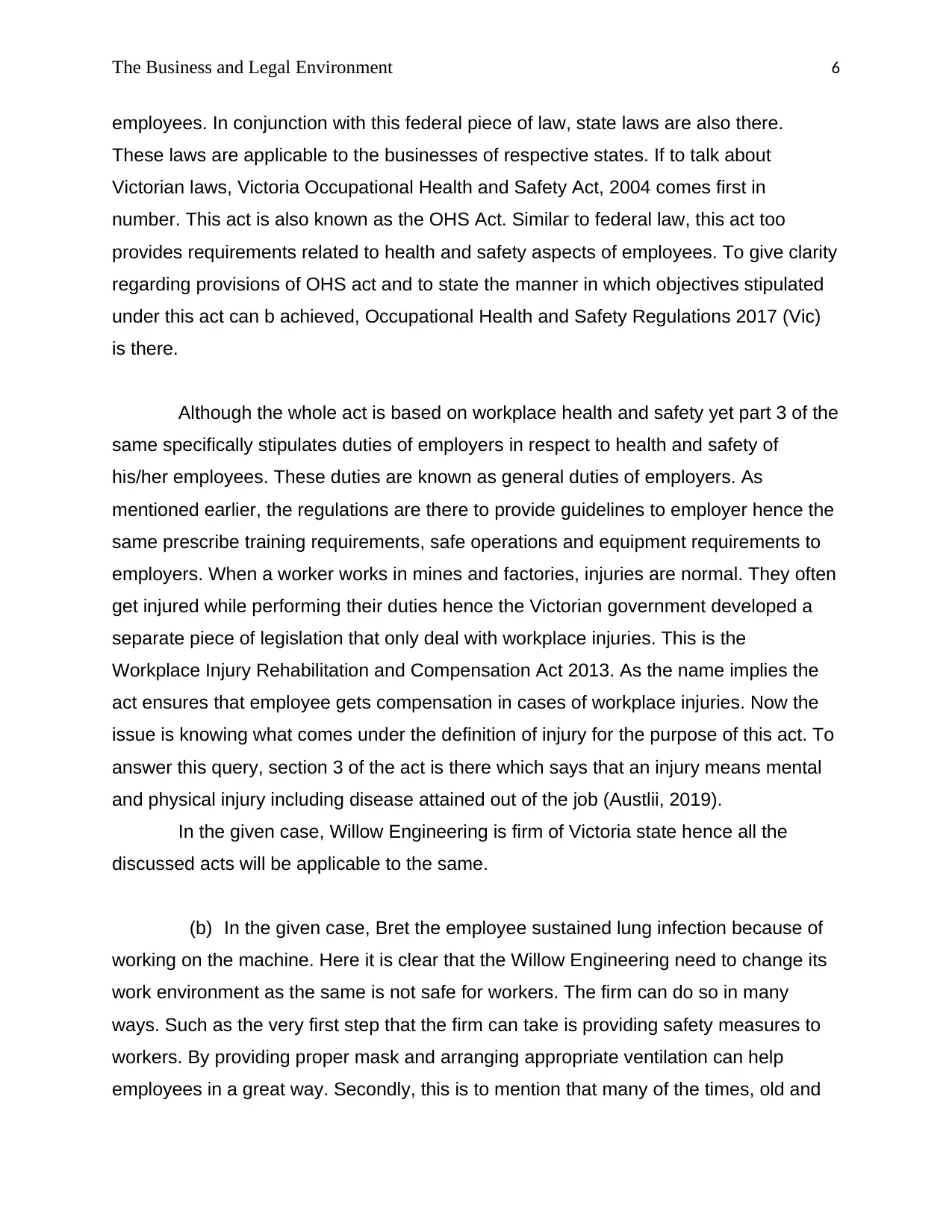
The Business and Legal Environment 6
employees. In conjunction with this federal piece of law, state laws are also there.
These laws are applicable to the businesses of respective states. If to talk about
Victorian laws, Victoria Occupational Health and Safety Act, 2004 comes first in
number. This act is also known as the OHS Act. Similar to federal law, this act too
provides requirements related to health and safety aspects of employees. To give clarity
regarding provisions of OHS act and to state the manner in which objectives stipulated
under this act can b achieved, Occupational Health and Safety Regulations 2017 (Vic)
is there.
Although the whole act is based on workplace health and safety yet part 3 of the
same specifically stipulates duties of employers in respect to health and safety of
his/her employees. These duties are known as general duties of employers. As
mentioned earlier, the regulations are there to provide guidelines to employer hence the
same prescribe training requirements, safe operations and equipment requirements to
employers. When a worker works in mines and factories, injuries are normal. They often
get injured while performing their duties hence the Victorian government developed a
separate piece of legislation that only deal with workplace injuries. This is the
Workplace Injury Rehabilitation and Compensation Act 2013. As the name implies the
act ensures that employee gets compensation in cases of workplace injuries. Now the
issue is knowing what comes under the definition of injury for the purpose of this act. To
answer this query, section 3 of the act is there which says that an injury means mental
and physical injury including disease attained out of the job (Austlii, 2019).
In the given case, Willow Engineering is firm of Victoria state hence all the
discussed acts will be applicable to the same.
(b) In the given case, Bret the employee sustained lung infection because of
working on the machine. Here it is clear that the Willow Engineering need to change its
work environment as the same is not safe for workers. The firm can do so in many
ways. Such as the very first step that the firm can take is providing safety measures to
workers. By providing proper mask and arranging appropriate ventilation can help
employees in a great way. Secondly, this is to mention that many of the times, old and
employees. In conjunction with this federal piece of law, state laws are also there.
These laws are applicable to the businesses of respective states. If to talk about
Victorian laws, Victoria Occupational Health and Safety Act, 2004 comes first in
number. This act is also known as the OHS Act. Similar to federal law, this act too
provides requirements related to health and safety aspects of employees. To give clarity
regarding provisions of OHS act and to state the manner in which objectives stipulated
under this act can b achieved, Occupational Health and Safety Regulations 2017 (Vic)
is there.
Although the whole act is based on workplace health and safety yet part 3 of the
same specifically stipulates duties of employers in respect to health and safety of
his/her employees. These duties are known as general duties of employers. As
mentioned earlier, the regulations are there to provide guidelines to employer hence the
same prescribe training requirements, safe operations and equipment requirements to
employers. When a worker works in mines and factories, injuries are normal. They often
get injured while performing their duties hence the Victorian government developed a
separate piece of legislation that only deal with workplace injuries. This is the
Workplace Injury Rehabilitation and Compensation Act 2013. As the name implies the
act ensures that employee gets compensation in cases of workplace injuries. Now the
issue is knowing what comes under the definition of injury for the purpose of this act. To
answer this query, section 3 of the act is there which says that an injury means mental
and physical injury including disease attained out of the job (Austlii, 2019).
In the given case, Willow Engineering is firm of Victoria state hence all the
discussed acts will be applicable to the same.
(b) In the given case, Bret the employee sustained lung infection because of
working on the machine. Here it is clear that the Willow Engineering need to change its
work environment as the same is not safe for workers. The firm can do so in many
ways. Such as the very first step that the firm can take is providing safety measures to
workers. By providing proper mask and arranging appropriate ventilation can help
employees in a great way. Secondly, this is to mention that many of the times, old and
Paraphrase This Document
Need a fresh take? Get an instant paraphrase of this document with our AI Paraphraser
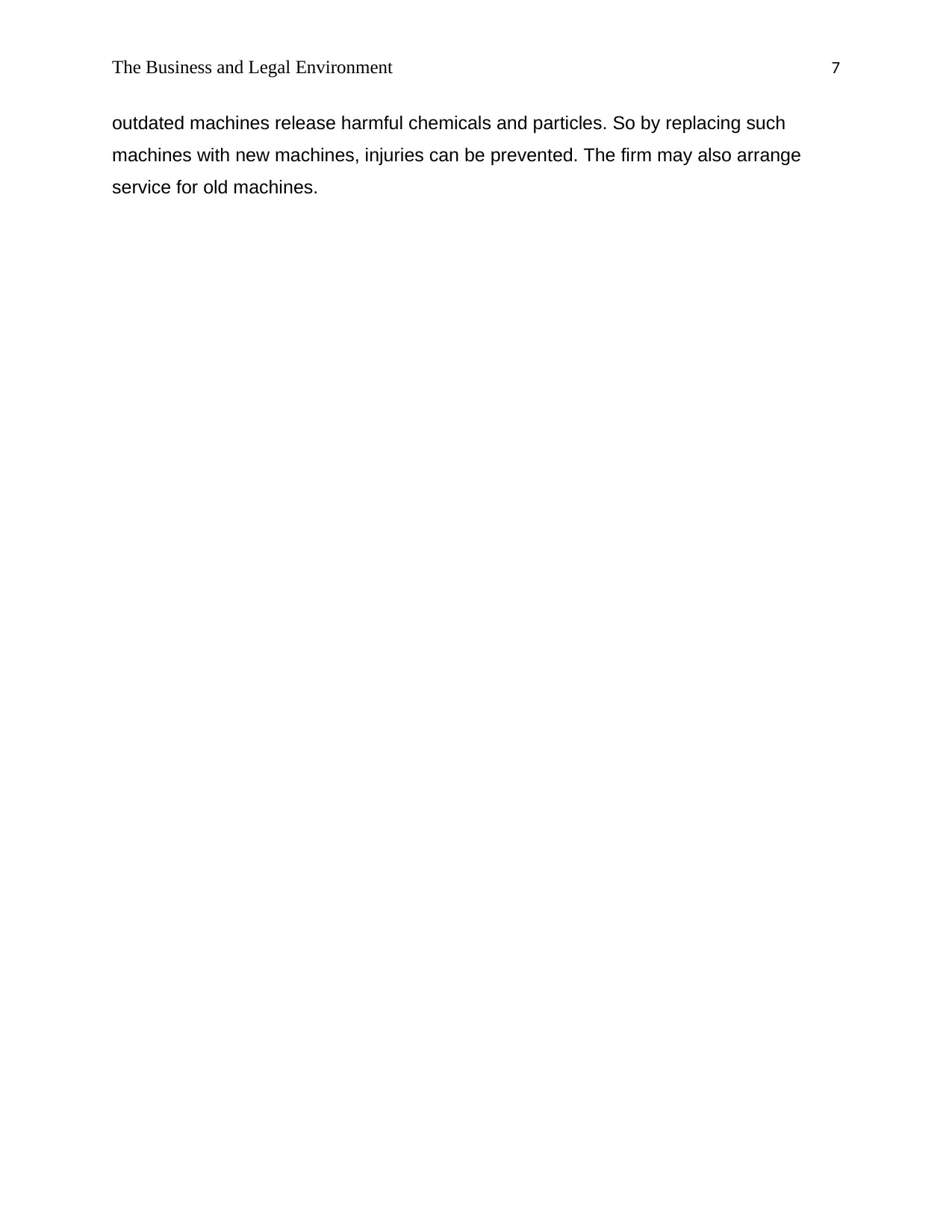
The Business and Legal Environment 7
outdated machines release harmful chemicals and particles. So by replacing such
machines with new machines, injuries can be prevented. The firm may also arrange
service for old machines.
outdated machines release harmful chemicals and particles. So by replacing such
machines with new machines, injuries can be prevented. The firm may also arrange
service for old machines.
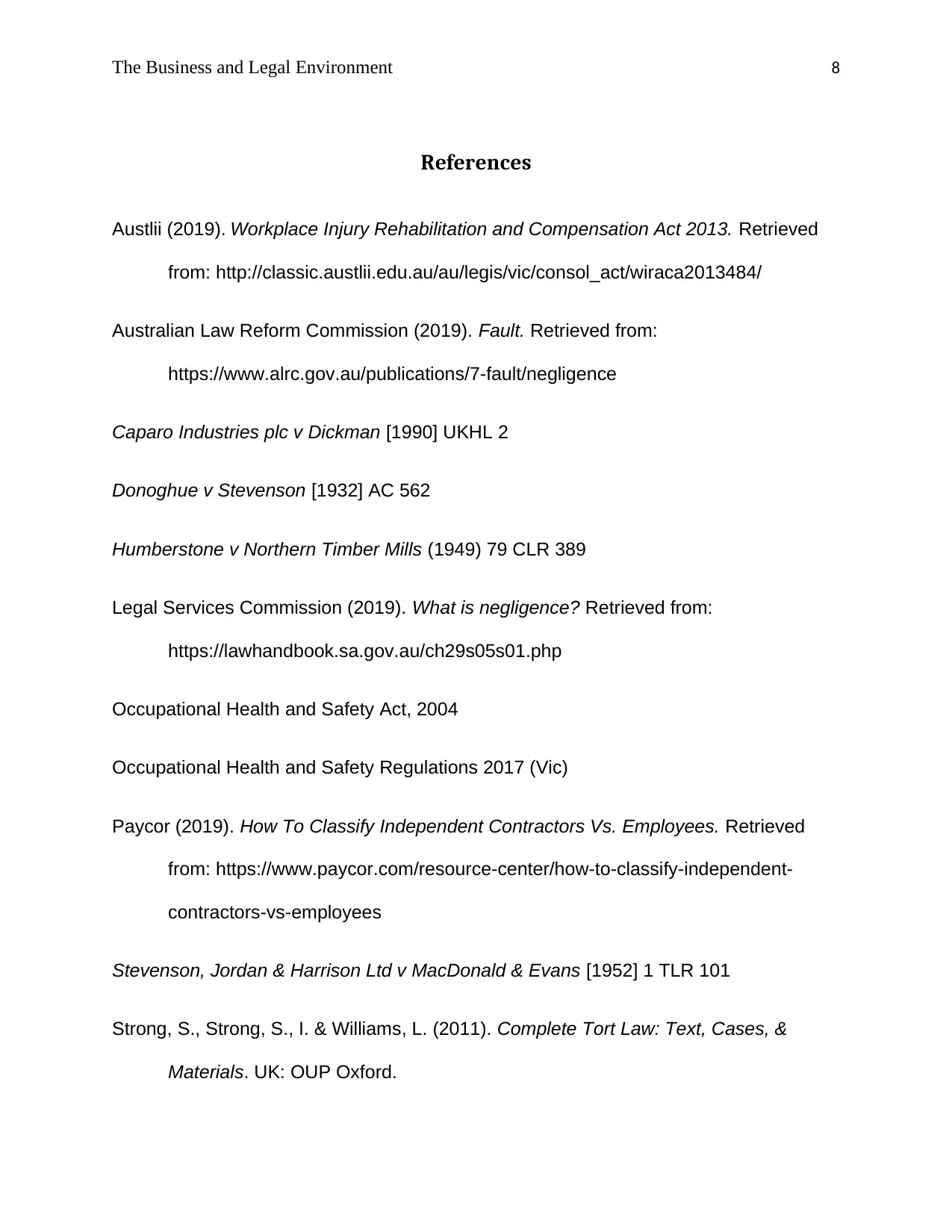
The Business and Legal Environment 8
References
Austlii (2019). Workplace Injury Rehabilitation and Compensation Act 2013. Retrieved
from: http://classic.austlii.edu.au/au/legis/vic/consol_act/wiraca2013484/
Australian Law Reform Commission (2019). Fault. Retrieved from:
https://www.alrc.gov.au/publications/7-fault/negligence
Caparo Industries plc v Dickman [1990] UKHL 2
Donoghue v Stevenson [1932] AC 562
Humberstone v Northern Timber Mills (1949) 79 CLR 389
Legal Services Commission (2019). What is negligence? Retrieved from:
https://lawhandbook.sa.gov.au/ch29s05s01.php
Occupational Health and Safety Act, 2004
Occupational Health and Safety Regulations 2017 (Vic)
Paycor (2019). How To Classify Independent Contractors Vs. Employees. Retrieved
from: https://www.paycor.com/resource-center/how-to-classify-independent-
contractors-vs-employees
Stevenson, Jordan & Harrison Ltd v MacDonald & Evans [1952] 1 TLR 101
Strong, S., Strong, S., I. & Williams, L. (2011). Complete Tort Law: Text, Cases, &
Materials. UK: OUP Oxford.
References
Austlii (2019). Workplace Injury Rehabilitation and Compensation Act 2013. Retrieved
from: http://classic.austlii.edu.au/au/legis/vic/consol_act/wiraca2013484/
Australian Law Reform Commission (2019). Fault. Retrieved from:
https://www.alrc.gov.au/publications/7-fault/negligence
Caparo Industries plc v Dickman [1990] UKHL 2
Donoghue v Stevenson [1932] AC 562
Humberstone v Northern Timber Mills (1949) 79 CLR 389
Legal Services Commission (2019). What is negligence? Retrieved from:
https://lawhandbook.sa.gov.au/ch29s05s01.php
Occupational Health and Safety Act, 2004
Occupational Health and Safety Regulations 2017 (Vic)
Paycor (2019). How To Classify Independent Contractors Vs. Employees. Retrieved
from: https://www.paycor.com/resource-center/how-to-classify-independent-
contractors-vs-employees
Stevenson, Jordan & Harrison Ltd v MacDonald & Evans [1952] 1 TLR 101
Strong, S., Strong, S., I. & Williams, L. (2011). Complete Tort Law: Text, Cases, &
Materials. UK: OUP Oxford.
⊘ This is a preview!⊘
Do you want full access?
Subscribe today to unlock all pages.

Trusted by 1+ million students worldwide
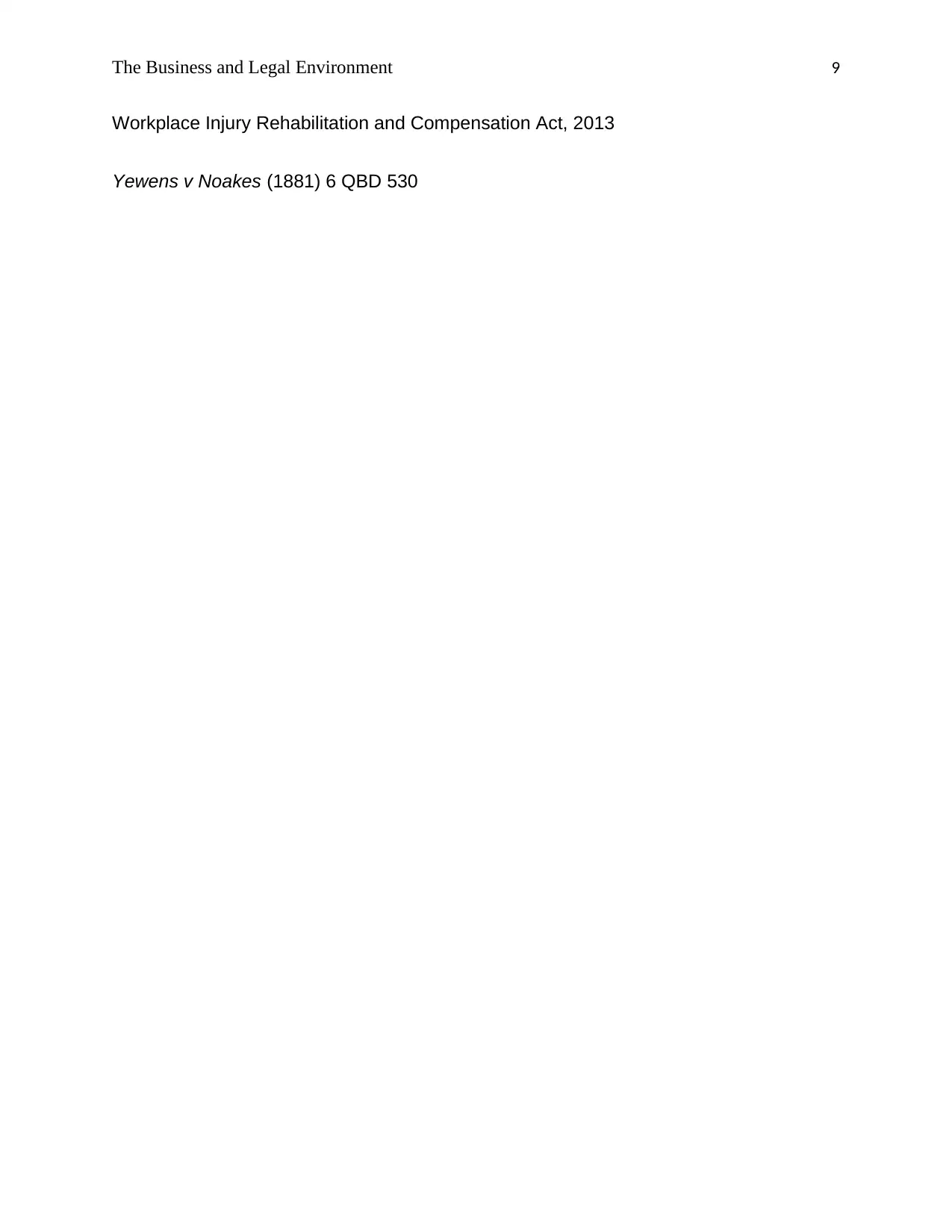
The Business and Legal Environment 9
Workplace Injury Rehabilitation and Compensation Act, 2013
Yewens v Noakes (1881) 6 QBD 530
Workplace Injury Rehabilitation and Compensation Act, 2013
Yewens v Noakes (1881) 6 QBD 530
1 out of 10
Related Documents
Your All-in-One AI-Powered Toolkit for Academic Success.
+13062052269
info@desklib.com
Available 24*7 on WhatsApp / Email
![[object Object]](/_next/static/media/star-bottom.7253800d.svg)
Unlock your academic potential
Copyright © 2020–2025 A2Z Services. All Rights Reserved. Developed and managed by ZUCOL.





